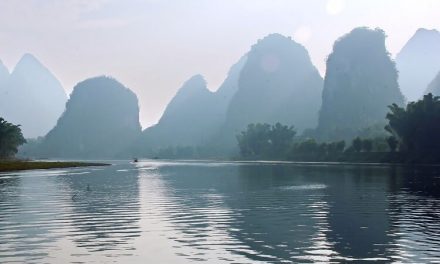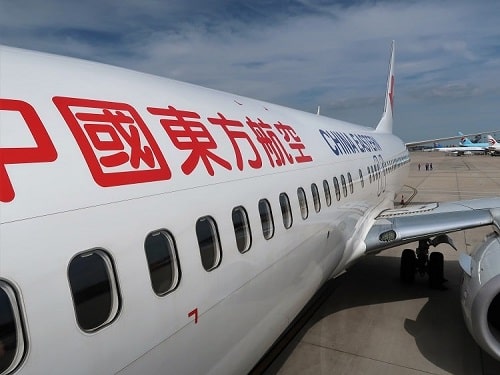Traveling to Tibet is one of the best adventures I’ve ever had in China.
I actually find it hard to describe Tibet.
When I returned home and my friends asked me, “How was Tibet?”, I replied by saying “I ate yak!”.
But Tibet is much more than a four-legged beast that tastes nice in soup.
There’s a deep spiritualism about the place, stunning landscapes, harsh conditions, and a history that’s so rich and messy it’s still politically sensitive after all these years.
If you decide to travel to Tibet, here’s 10 things I think you should know.
1. You need a permit to get in

My Tibet permit was couriered to my hotel in Beijing. Image supplied by Mike Cairnduff.
Tibet is the only place in China where you need a special permit to get in.
And when I say permit, I mean an actual piece of paper that’s indecipherable (unless you can read Chinese or Tibetan scripture).
The only way you can get a permit is by signing up to a tour with a travel agency. This way, the Chinese government can monitor exactly who’s in the province, and where they are.
I flew from Beijing to the Tibetan capital, Lhasa, and had to present my permit at Beijing Airport just to get through the security checks.
You also need to show it when you arrive in Lhasa, and your hotel will even ask to see it and take a copy of it.
So, there’s no getting around this requirement – you must join a tour to get the permit.
I chose a travel agency called Tibet Vista and they were great to deal with.
2. It’s hard to get to

You’re welcomed with a white scarf once you get here. Image supplied by Mike Cairnduff.
A high-speed railway is currently being built between Lhasa and the home of the pandas, Chengdu.
This will make it so much easier to get to Tibet. (It will also change the culture of the place as hordes of domestic tourists pile in – but that’s a debate for another day.)
In the meantime, your transport options are limited.
There are very few direct international flights, so you’re likely going to fly in via another Chinese city (but this is OK as your tour company will courier the permit to your hotel).
There’s also a slow train which takes about 20 hours from Xining.
A few people in my tour group took the train and said it wasn’t worth it, given there’s only a few hours of pretty landscapes and the rest of the journey is kind of unforgettable.
They said the clean toilets were the redeeming feature. That’s saying a lot.
A lot of people also don’t realize how far Tibet is from the rest of China.
My flight from Beijing took four hours, and flights from other cities on the east coast, like Shanghai, take just as long.
3. Chances are you’ll get sick

The high altitude can mess with your health. Image supplied by Mike Cairnduff.
Tibet isn’t called “the roof of the world” for nothing.
At roughly 4,000 meters (13,000 feet) above sea level, the air in Tibet is super thin. This means you’re taking in less oxygen due to the high altitude.
Luckily, I did my research before I jetted off, and got a doctor’s prescription for a drug called Diamox.
Everyone else on the tour was on it too, except a British lad who reassured me he’d recently been hiking up high mountains in Yunnan “to help him acclimatize” for Tibet.
By Day 3, he was wiped out with nausea.
I guess the Diamox helped me, but I still felt gross most mornings and nights in my hotel room.
Breakfast and coffee didn’t help. I think it’s once I got walking (slowly) outside that I started to acclimatize to the air.
I felt worse during the middle of the night, when I would wake up feeling a bit breathless.
My guide said I’d be acclimatized within seven days – the length of my tour.
You can request oxygen in your hotel room if it gets really bad, and there’s a tank in your tour bus too.
It’s hard to put the feeling of high-altitude sickness into words.
I’d say it’s like a hangover in your 20s – you feel off but you know it will go away soon.
4. It’s the most expensive destination in China

Luckily, food isn’t too pricey (including this yak stew I tried). Image supplied by Mike Cairnduff.
The mandatory requirement to join a tour and get a permit puts a lot of travelers off.
Less people going into the region means tours are pricy as there’s less competition.
Domestic flights are also limited, and the ones that do fly in the middle of the day can be outrageously priced.
For example, my Beijing-Lhasa return flight cost RMB 6,000. This is USD 840 / EUR 730 / AUD 1,290.
Once you’re there though, food and other general costs are OK and roughly similar to the rest of western China.
5. The weather is brutal

Challenging weather didn’t deter this singer. Image supplied by Mike Cairnduff.
For about five months of the year, from November to March, the weather in Tibet is brutally cold.
On the other hand, summer (June-August) is surprisingly roasting hot, and there are hordes of local tourists as it’s school holidays.
If you are like me and prefer traveling outside extreme weather periods, you could travel in one of the ‘sweet spots’.
But the thing is, these spots are quite short and many other tourists will have the same idea as you.
I traveled in early September, which was still surprisingly hot, though the nights were cool. I recommend traveling at this time, or in May in the late autumn/fall.
Try to avoid traveling during Chinese holidays, as this is when the local folk from other provinces like to travel around.
6. You have to be social

You’ll share meals as part of your Tibetan tour group. Image supplied by Mike Cairnduff.
You don’t have to be extroverted, but you have to at least be a little bit social to enjoy Tibet. This is because you’ll do everything as a group.
You will:
- Go to the same places
- Share the same tour bus
- Eat most meals together
- Stay at the same hotels.
It’s just hard to get away from the others on the tour. Your hotel room will be your only private space.
This was a bit of an adjustment for me as I’ve only ever traveled China on my own or with friends whom I’ve known for a long time.
I was lucky that the other travelers on my Tibet small group tour were lovely and cool. I felt that everyone was respectful of Tibet too.
7. You have to keep your trap shut

The stunning Potala Palace at dusk. Image supplied by Mike Cairnduff.
I love the pink paper notice I was given on arrival, which outlines the do’s and don’ts of travel in Tibet.
Some of my favorite rules are:
- “Do not do things that are beyond your tourist identity”
- “Do not accept any news media’s interview”
- “Do not collect secret intelligence”
- “Do not wave antisocial banners, yelling antisocial slogans”
If you don’t keep your trap shut, you could end up like Brad Pitt or Richard Gere, both of whom have been banned from entering Tibet.
8. It’s more touristy than you think

For 20 yuan, you can jump on a yak! Image supplied by Mike Cairnduff.
Tibet is no different to all the other famous places in China – it’s heaving with tourists.
I was initially surprised by this, given the extra requirement (and cost) to get in.
At all the main touristy places, you’ll see local tourists sucking on portable oxygen canisters, and busloads of foreigners from every corner of the globe.
Granted, I didn’t really get off the beaten track, and I suppose most other tourists don’t either.
So if you have the money, and you can book a totally private tour, perhaps you can explore the quieter, less touristy places.
9. It’s all landscapes, monks and monasteries

I feel like my photo should win an award! Lol. Image supplied by Mike Cairnduff.
I never got sick of staring at the huge mountains and unusual terrain. Tibet is a wildly beautiful place.
If you can appreciate the serenity of Buddhism, you will love all the ancient monasteries and monks who still live there.
Speaking of monks, I did find it funny that they all wear the traditional robe yet have the best Nike footwear.
When I asked my tour guide about this, he said the shoes are donated by locals. Monks can’t earn a salary.
10. Lhasa is modern and ‘Chinese’

One of the main streets in downtown Lhasa. Image supplied by Mike Cairnduff.
If it weren’t for the spectacular Potala Palace that imposes over the city, Lhasa would feel like any other city in China.
It’s modern, clean, full of concrete and homogenously Chinese. Meh!
Mandarin is the dominant language – at least when it comes to signage and what the kids have to learn in school.
I had the most fun when our tour bus went outside of Lhasa and into the smaller towns.
A few people I’d met at the hotel, who were with the same tour company, went as far as Mount Everest Base Camp.
I chose not to go, as I’m not a big hiker and I’ve never really felt the urge to go to Everest.
It would have been purely for my ego.
Anyway, I digress. If you want to explore a totally different part of China which has a unique culture and is full of Buddhist history, I highly recommend a trip to Tibet.
It’s amazing and special and, for many of us including me, a once-in-a-lifetime experience.
Don’t forget your eSIM
When you’re out and about in China, you’re going to need phone data.
One of the main reasons for this is because China is practically cashless, and you’ll be using WeChat Pay or Alipay to pay for everything.
I highly recommend getting an eSIM with an in-built VPN so you can access all the foreign websites and apps that are blocked in China too.
Check out my China eSIM review here, or get the one I recommend most here:
Just remember to install the eSIM a day or so before you touch down in China.
If you want to keep reading about this part of the world, visit the China travel blog or check out the helpful article I wrote about the must-have China travel apps for your phone.
FAQ about traveling to Tibet
Are tourists allowed to visit Tibet?
Absolutely! Tourism is one of the province’s key economic markets. Just make sure you arrange a permit by going on an accredited tour.
Why is travel to Tibet restricted?
It’s been a politically sensitive area for a long time, and especially since the late 1950s when China annexed Tibet and the Dalai Lama fled to India.
Is it safe to travel to Tibet?
Yes. There are no safety concerns unless you have respiratory issues, in which case you might want to chat to your doctor before going.
Can you go to Tibet without a tour?
No. The tour companies issue the permits.
Do they drink alcohol in Tibet?
Yes they do, and there’s a local brew called Chang which is a barley wine. It’s like beer without the fizz rather than normal wine. It tastes alright!












